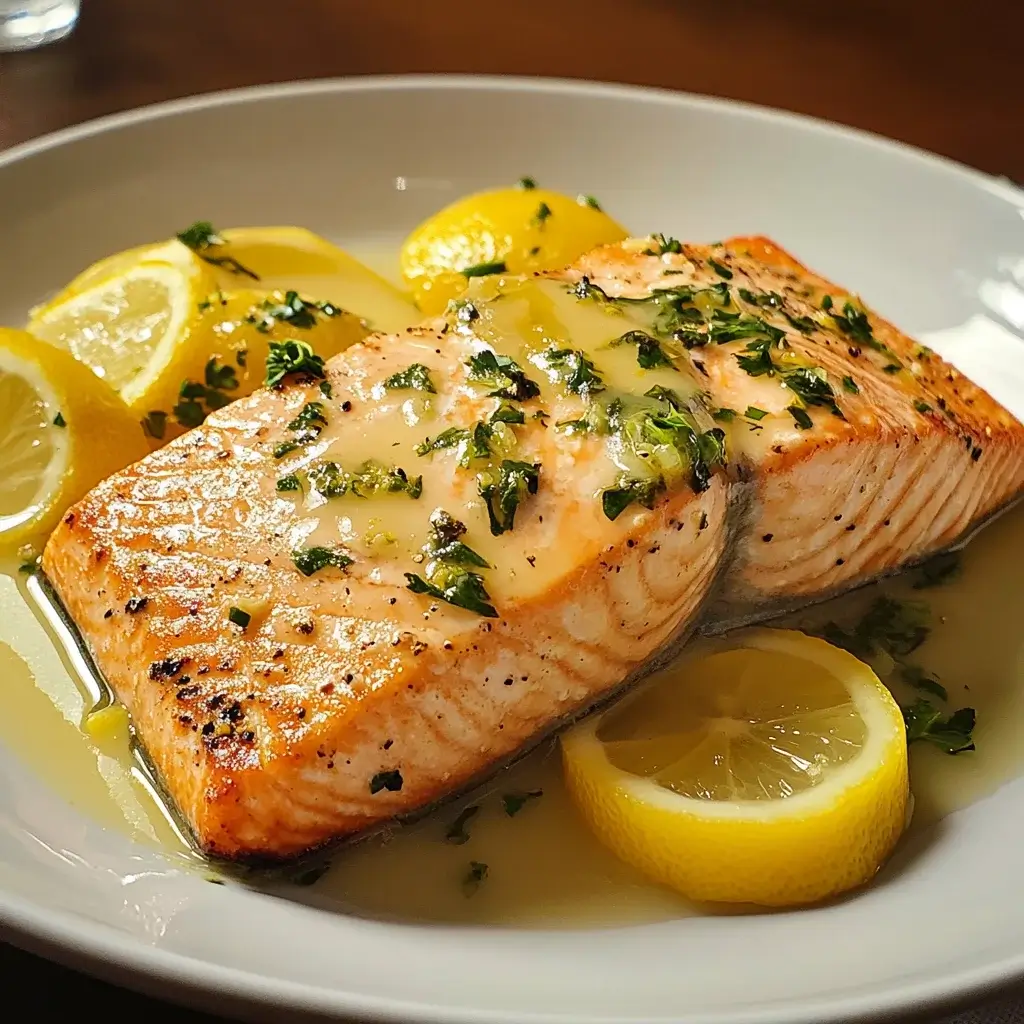It’s Easter Sunday, and the aroma wafting from the kitchen is simply divine. This year, instead of the usual ham, we decided to try something lighter, brighter, and utterly delicious – Baked Easter Salmon with Lemon Butter Sauce. Let me tell you, it was a resounding success! From the moment the flaky, perfectly cooked salmon hit our plates, drizzled with that luscious, tangy lemon butter sauce, my family was hooked. Even my youngest, who can be a bit picky with fish, devoured every last bite. The vibrant flavors, the ease of preparation, and the elegant presentation made it the perfect centerpiece for our Easter feast. This recipe isn’t just for Easter though; it’s become a regular in our rotation for any special occasion or even a simple weeknight dinner when we crave something healthy and flavorful. Trust me, once you try this Baked Easter Salmon with Lemon Butter Sauce, it will become a cherished recipe in your home too.
Ingredients
- Salmon Fillets: Fresh, skin-on or skinless salmon fillets, about 1.5-2 pounds total. Choose center-cut fillets for even cooking and best presentation.
- Butter: Unsalted butter, the base of our rich and flavorful lemon butter sauce. Using unsalted butter allows you to control the saltiness of the dish.
- Lemons: Fresh lemons, both for zest and juice. Lemons provide the bright, citrusy notes that perfectly complement the salmon and butter.
- Garlic: Fresh garlic cloves, minced. Garlic adds a savory depth to the sauce, balancing the lemon’s acidity.
- Fresh Parsley: Fresh parsley, chopped. Parsley brings a fresh, herbaceous element to the sauce and adds a pop of color.
- Dried Dill: Dried dill weed. Dill complements both salmon and lemon beautifully, enhancing the overall flavor profile.
- Olive Oil: Extra virgin olive oil. Used to lightly coat the salmon before baking, promoting moisture and even cooking.
- Salt: Kosher salt or sea salt. Essential for seasoning both the salmon and the sauce, enhancing all the flavors.
- Black Pepper: Freshly ground black pepper. Adds a subtle spice and complexity to the dish.
Instructions
- Preheat Your Oven and Prepare the Baking Sheet: Begin by preheating your oven to 400°F (200°C). This temperature is ideal for baking salmon, ensuring it cooks through without drying out too quickly. While the oven is preheating, prepare a baking sheet. Line it with parchment paper or aluminum foil for easy cleanup. This also prevents the salmon from sticking to the pan. If using foil, you can lightly grease it with cooking spray or olive oil to further ensure non-sticking.
- Prepare the Salmon Fillets: Rinse the salmon fillets under cold water and pat them completely dry with paper towels. Excess moisture can steam the salmon rather than bake it, preventing a nice sear and potentially leading to a less flavorful result. Once dry, place the salmon fillets on the prepared baking sheet, skin-side down if using skin-on fillets. If you are using skinless fillets, simply place them directly on the baking sheet. Space them out evenly so they cook uniformly.
- Season the Salmon: Lightly brush the salmon fillets with olive oil. This helps the seasonings adhere and also contributes to a moist and flavorful final product. Season generously with salt and freshly ground black pepper. Don’t be shy with the seasoning; salmon can handle a good amount of salt and pepper. Distribute the seasoning evenly over the surface of each fillet.
- Bake the Salmon: Place the baking sheet with the seasoned salmon into the preheated oven. Bake for approximately 12-15 minutes, or until the salmon is cooked through and flakes easily with a fork. The exact baking time will depend on the thickness of your salmon fillets. To check for doneness, gently insert a fork into the thickest part of a fillet. If it flakes easily and is no longer translucent in the center, it is cooked. Avoid overbaking, as this will result in dry salmon. For thicker fillets, you may need to bake for a few minutes longer. Keep a close eye on the salmon during the last few minutes of baking to prevent overcooking.
- Prepare the Lemon Butter Sauce While Salmon Bakes: While the salmon is baking, you can prepare the luscious lemon butter sauce. This sauce comes together quickly and elevates the salmon to a gourmet level. In a small saucepan, melt the unsalted butter over medium-low heat. Keep the heat low to prevent the butter from browning too quickly or burning.
- Add Garlic and Cook Briefly: Once the butter is melted, add the minced garlic to the saucepan. Sauté the garlic for about 1-2 minutes, or until it becomes fragrant and softened but not browned. Be careful not to burn the garlic, as burnt garlic will impart a bitter taste to the sauce. Stir constantly while sautéing the garlic to ensure even cooking.
- Add Lemon Zest and Juice: Remove the saucepan from the heat. Stir in the lemon zest and lemon juice. The zest adds a concentrated lemon flavor and aroma, while the juice provides the essential tangy and bright acidity. Use a microplane or fine grater to zest the lemon, ensuring you only get the yellow part of the peel and avoid the bitter white pith. Freshly squeezed lemon juice is crucial for the best flavor; avoid using bottled lemon juice if possible.
- Stir in Herbs and Season: Add the chopped fresh parsley and dried dill to the lemon butter sauce. Stir well to combine all the ingredients. Season the sauce with a pinch of salt and black pepper to taste. Taste the sauce and adjust the seasoning as needed. You may want to add a little more lemon juice for extra tanginess or a bit more salt to balance the flavors.
- Serve the Baked Salmon with Lemon Butter Sauce: Once the salmon is baked to perfection, carefully remove it from the oven. Transfer the baked salmon fillets to serving plates. Generously spoon the freshly made lemon butter sauce over each salmon fillet. Ensure each fillet is well-coated with the sauce to maximize flavor. Garnish with extra fresh parsley sprigs or lemon wedges, if desired, for an added touch of freshness and visual appeal. Serve immediately and enjoy this delightful Baked Easter Salmon with Lemon Butter Sauce!
Nutrition Facts
Serving Size: 1 Salmon Fillet (approximately 4-6 oz cooked salmon with sauce)
(Nutritional information is an estimate and may vary based on specific ingredients and portion sizes)
- Calories: 350
- Protein: 35g
- Fat: 22g
Preparation Time
Prep Time: 15 minutes
Cook Time: 15 minutes
Total Time: 30 minutes
This Baked Easter Salmon with Lemon Butter Sauce is incredibly quick and easy to prepare, making it perfect for a weeknight meal or a stress-free holiday gathering. From start to finish, you’ll have a flavorful and healthy dish on the table in just about half an hour. The simple steps and readily available ingredients ensure that even novice cooks can achieve restaurant-quality results with minimal effort.
How to Serve
This Baked Easter Salmon with Lemon Butter Sauce is versatile and pairs beautifully with a variety of side dishes. Here are some delicious serving suggestions:
- Classic Vegetable Sides:
- Roasted Asparagus: A spring classic that complements salmon perfectly. Toss asparagus spears with olive oil, salt, and pepper, and roast alongside the salmon for the last 10-12 minutes.
- Steamed Green Beans: Simple and healthy, steamed green beans offer a fresh and crisp contrast to the rich salmon and sauce.
- Broccoli Florets: Roasted or steamed broccoli, lightly seasoned, is another excellent vegetable pairing that adds nutritional value and texture.
- Garlic Parmesan Spinach: Sautéed spinach with garlic and a sprinkle of Parmesan cheese is a flavorful and nutritious side dish.
- Carbohydrate Companions:
- Roasted Potatoes: Rosemary roasted potatoes or lemon roasted potatoes enhance the Easter theme and provide a hearty side.
- Quinoa: A healthy and protein-rich grain that soaks up the lemon butter sauce beautifully.
- Rice Pilaf: A light and fluffy rice pilaf, perhaps with herbs and lemon zest, complements the salmon without being too heavy.
- Creamy Polenta: For a more indulgent side, creamy polenta provides a smooth and comforting base for the salmon.
- Fresh and Bright Salads:
- Spring Salad with Lemon Vinaigrette: A light and refreshing salad with mixed greens, seasonal vegetables, and a bright lemon vinaigrette echoes the lemon flavors in the salmon.
- Cucumber and Dill Salad: A simple cucumber salad with fresh dill and a light dressing offers a cool and crisp counterpoint to the richness of the salmon.
- Caprese Salad: The fresh flavors of tomatoes, mozzarella, and basil provide a classic and elegant salad option.
- Bread for Sopping Up Sauce:
- Crusty Bread: Serve with crusty bread or baguette slices to soak up every last drop of the delicious lemon butter sauce.
- Garlic Bread: Garlic bread is always a crowd-pleaser and pairs well with the savory flavors of the dish.
Additional Tips for Perfect Baked Easter Salmon
- Choose High-Quality Salmon: The quality of your salmon significantly impacts the final dish. Opt for fresh, wild-caught or sustainably farmed salmon if possible. Look for fillets that are vibrant in color and have a fresh, clean scent.
- Don’t Overcrowd the Baking Sheet: Give the salmon fillets enough space on the baking sheet. Overcrowding can lead to steaming instead of baking, resulting in unevenly cooked and potentially soggy salmon. If necessary, use two baking sheets or bake in batches.
- Pat the Salmon Dry: As mentioned earlier, patting the salmon dry before seasoning is crucial. This removes excess moisture and allows the seasonings to adhere better, promoting a beautiful sear and preventing a watery result.
- Adjust Baking Time Based on Thickness: Salmon fillets vary in thickness. Adjust the baking time accordingly. Thicker fillets will require a few more minutes of baking time. Always check for doneness by flaking with a fork in the thickest part.
- Enhance the Lemon Flavor: For an even more intense lemon flavor, try adding thinly sliced lemon rounds under the salmon fillets while baking. This infuses the salmon with lemon from the bottom up.
- Customize the Herbs: Feel free to experiment with different herbs in the lemon butter sauce. Thyme, rosemary, or chives would also be delicious additions or substitutions for parsley and dill.
- Make-Ahead Sauce (Partially): You can prepare the lemon butter sauce ahead of time, up to a few hours before baking the salmon. Simply melt the butter, sauté the garlic, and then remove from heat. Stir in the lemon zest and juice just before serving to maintain the fresh citrus flavor. Heat the sauce gently before drizzling over the baked salmon.
- Garnish for Presentation: A sprinkle of fresh parsley, dill sprigs, or lemon wedges adds a final touch of freshness and visual appeal to the dish. Consider adding a pinch of red pepper flakes for a subtle hint of spice and color contrast.
FAQ Section: Your Questions Answered
Q1: Can I use frozen salmon for this recipe?
A: Yes, you can use frozen salmon. Ensure it is fully thawed before baking. Thaw it overnight in the refrigerator or use the cold water thawing method for quicker thawing. Pat it very dry after thawing to remove excess moisture.
Q2: Can I make the lemon butter sauce dairy-free?
A: Yes, you can make a dairy-free version of the lemon butter sauce. Substitute the butter with a high-quality vegan butter alternative or olive oil. The flavor will be slightly different, but still delicious.
Q3: How do I store leftover baked salmon?
A: Store leftover baked salmon in an airtight container in the refrigerator for up to 2-3 days. Reheat gently in the oven or microwave until warmed through. It’s best enjoyed within a day or two for optimal texture and flavor.
Q4: Can I prepare this recipe ahead of time?
A: While the salmon is best served fresh from the oven, you can prep some components ahead. You can make the lemon butter sauce partially in advance (as mentioned in the tips). You can also season the salmon fillets ahead of time and keep them covered in the refrigerator for up to an hour before baking.
Q5: What wine pairs well with Baked Easter Salmon with Lemon Butter Sauce?
A: A crisp white wine pairs beautifully with this dish. Consider a Sauvignon Blanc, Pinot Grigio, or unoaked Chardonnay. The acidity and citrus notes in these wines complement the lemon butter sauce and the richness of the salmon. A dry rosé would also be a lovely choice.
Q6: Can I add vegetables to bake with the salmon on the same sheet pan?
A: Absolutely! You can roast vegetables alongside the salmon. Asparagus, broccoli, bell peppers, or cherry tomatoes are great options. Add vegetables that have similar cooking times to salmon, or add heartier vegetables like potatoes or carrots earlier in the baking process.
Q7: What if I don’t have fresh parsley or dill? Can I use dried herbs?
A: While fresh herbs are preferred for their brighter flavor, you can use dried herbs in a pinch. Use about 1 teaspoon of dried parsley and 1 teaspoon of dried dill as substitutes for the fresh amounts. Add them to the sauce as directed.
Q8: Can I bake the salmon with the skin on or skin off?
A: You can bake salmon with the skin on or skin off – it’s a matter of personal preference. Skin-on salmon can be slightly more moist as the skin helps to protect the fillet during baking. If using skin-on, you can choose to eat the skin or remove it after baking. Skinless salmon is also delicious and cooks evenly.
Print
Baked Easter Salmon with Lemon Butter Sauce
Ingredients
- Salmon Fillets: Fresh, skin-on or skinless salmon fillets, about 1.5-2 pounds total. Choose center-cut fillets for even cooking and best presentation.
- Butter: Unsalted butter, the base of our rich and flavorful lemon butter sauce. Using unsalted butter allows you to control the saltiness of the dish.
- Lemons: Fresh lemons, both for zest and juice. Lemons provide the bright, citrusy notes that perfectly complement the salmon and butter.
- Garlic: Fresh garlic cloves, minced. Garlic adds a savory depth to the sauce, balancing the lemon’s acidity.
- Fresh Parsley: Fresh parsley, chopped. Parsley brings a fresh, herbaceous element to the sauce and adds a pop of color.
- Dried Dill: Dried dill weed. Dill complements both salmon and lemon beautifully, enhancing the overall flavor profile.
- Olive Oil: Extra virgin olive oil. Used to lightly coat the salmon before baking, promoting moisture and even cooking.
- Salt: Kosher salt or sea salt. Essential for seasoning both the salmon and the sauce, enhancing all the flavors.
- Black Pepper: Freshly ground black pepper. Adds a subtle spice and complexity to the dish.
Instructions
- Preheat Your Oven and Prepare the Baking Sheet: Begin by preheating your oven to 400°F (200°C). This temperature is ideal for baking salmon, ensuring it cooks through without drying out too quickly. While the oven is preheating, prepare a baking sheet. Line it with parchment paper or aluminum foil for easy cleanup. This also prevents the salmon from sticking to the pan. If using foil, you can lightly grease it with cooking spray or olive oil to further ensure non-sticking.
- Prepare the Salmon Fillets: Rinse the salmon fillets under cold water and pat them completely dry with paper towels. Excess moisture can steam the salmon rather than bake it, preventing a nice sear and potentially leading to a less flavorful result. Once dry, place the salmon fillets on the prepared baking sheet, skin-side down if using skin-on fillets. If you are using skinless fillets, simply place them directly on the baking sheet. Space them out evenly so they cook uniformly.
- Season the Salmon: Lightly brush the salmon fillets with olive oil. This helps the seasonings adhere and also contributes to a moist and flavorful final product. Season generously with salt and freshly ground black pepper. Don’t be shy with the seasoning; salmon can handle a good amount of salt and pepper. Distribute the seasoning evenly over the surface of each fillet.
- Bake the Salmon: Place the baking sheet with the seasoned salmon into the preheated oven. Bake for approximately 12-15 minutes, or until the salmon is cooked through and flakes easily with a fork. The exact baking time will depend on the thickness of your salmon fillets. To check for doneness, gently insert a fork into the thickest part of a fillet. If it flakes easily and is no longer translucent in the center, it is cooked. Avoid overbaking, as this will result in dry salmon. For thicker fillets, you may need to bake for a few minutes longer. Keep a close eye on the salmon during the last few minutes of baking to prevent overcooking.
- Prepare the Lemon Butter Sauce While Salmon Bakes: While the salmon is baking, you can prepare the luscious lemon butter sauce. This sauce comes together quickly and elevates the salmon to a gourmet level. In a small saucepan, melt the unsalted butter over medium-low heat. Keep the heat low to prevent the butter from browning too quickly or burning.
- Add Garlic and Cook Briefly: Once the butter is melted, add the minced garlic to the saucepan. Sauté the garlic for about 1-2 minutes, or until it becomes fragrant and softened but not browned. Be careful not to burn the garlic, as burnt garlic will impart a bitter taste to the sauce. Stir constantly while sautéing the garlic to ensure even cooking.
- Add Lemon Zest and Juice: Remove the saucepan from the heat. Stir in the lemon zest and lemon juice. The zest adds a concentrated lemon flavor and aroma, while the juice provides the essential tangy and bright acidity. Use a microplane or fine grater to zest the lemon, ensuring you only get the yellow part of the peel and avoid the bitter white pith. Freshly squeezed lemon juice is crucial for the best flavor; avoid using bottled lemon juice if possible.
- Stir in Herbs and Season: Add the chopped fresh parsley and dried dill to the lemon butter sauce. Stir well to combine all the ingredients. Season the sauce with a pinch of salt and black pepper to taste. Taste the sauce and adjust the seasoning as needed. You may want to add a little more lemon juice for extra tanginess or a bit more salt to balance the flavors.
- Serve the Baked Salmon with Lemon Butter Sauce: Once the salmon is baked to perfection, carefully remove it from the oven. Transfer the baked salmon fillets to serving plates. Generously spoon the freshly made lemon butter sauce over each salmon fillet. Ensure each fillet is well-coated with the sauce to maximize flavor. Garnish with extra fresh parsley sprigs or lemon wedges, if desired, for an added touch of freshness and visual appeal. Serve immediately and enjoy this delightful Baked Easter Salmon with Lemon Butter Sauce!
Nutrition
- Serving Size: one normal portion
- Calories: 350
- Fat: 22g
- Protein: 35g



